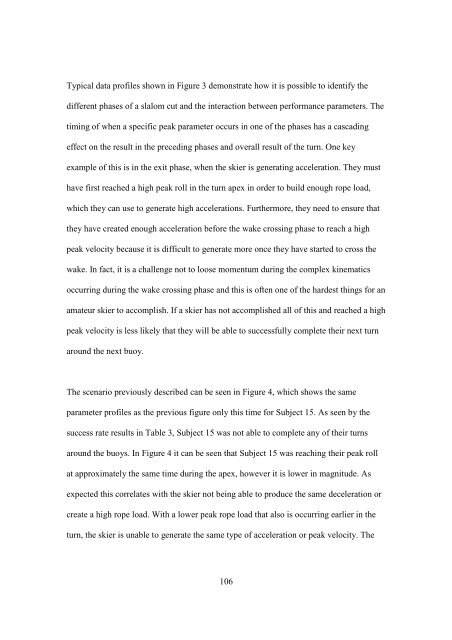Biomechanical P ... Slalom Water Skiing R1.pdf - Atrium - University ...
Biomechanical P ... Slalom Water Skiing R1.pdf - Atrium - University ...
Biomechanical P ... Slalom Water Skiing R1.pdf - Atrium - University ...
- No tags were found...
Create successful ePaper yourself
Turn your PDF publications into a flip-book with our unique Google optimized e-Paper software.
Typical data profiles shown in Figure 3 demonstrate how it is possible to identify thedifferent phases of a slalom cut and the interaction between performance parameters. Thetiming of when a specific peak parameter occurs in one of the phases has a cascadingeffect on the result in the preceding phases and overall result of the turn. One keyexample of this is in the exit phase, when the skier is generating acceleration. They musthave first reached a high peak roll in the turn apex in order to build enough rope load,which they can use to generate high accelerations. Furthermore, they need to ensure thatthey have created enough acceleration before the wake crossing phase to reach a highpeak velocity because it is difficult to generate more once they have started to cross thewake. In fact, it is a challenge not to loose momentum during the complex kinematicsoccurring during the wake crossing phase and this is often one of the hardest things for anamateur skier to accomplish. If a skier has not accomplished all of this and reached a highpeak velocity is less likely that they will be able to successfully complete their next turnaround the next buoy.The scenario previously described can be seen in Figure 4, which shows the sameparameter profiles as the previous figure only this time for Subject 15. As seen by thesuccess rate results in Table 3, Subject 15 was not able to complete any of their turnsaround the buoys. In Figure 4 it can be seen that Subject 15 was reaching their peak rollat approximately the same time during the apex, however it is lower in magnitude. Asexpected this correlates with the skier not being able to produce the same deceleration orcreate a high rope load. With a lower peak rope load that also is occurring earlier in theturn, the skier is unable to generate the same type of acceleration or peak velocity. The106
















